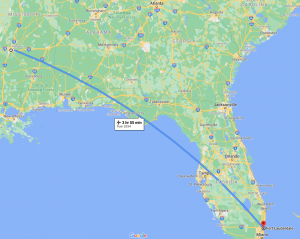Second Trimester Abortion Mississippi Residents – We can help.
Dr. Michael Benjamin abortion clinic in Ft. Lauderdale, Florida offers expert abortion and reproductive healthcare services to patients traveling from Mississippi. As a specialist in second trimester abortion care from 17 through 24 weeks of pregnancy, we are the most sought after abortion clinic for second trimester abortion Mississippi residents.
At Dr. Benjamin’s office we believe that every person should have the freedom to control their body. Should you decide to have an abortion, we offer the Abortion Pill up to 10 weeks, in-clinic Early Surgical Abortion up to 15 weeks, and in-clinic Surgical Abortion from 16 weeks through 24 weeks, commonly known as a second trimester abortion.
One in four will terminate a pregnancy during their lifetime. You are not alone in your decision to have an abortion — we are here for you because you deserve the very best.
Why second trimester abortion Mississippi residents choose us
- Florida is accessible from Mississippi by car | Jackson to Ft. Lauderdale under 13 1/2 hrs. | Gas & Food
- Florida is accessible from Mississippi by affordable airfare | Jackson to Ft. Lauderdale about 4 hrs flight | Under $125 Round Trip
- Financial Assistance is immediately available to ALL patients that qualify | Including, those traveling across state lines
- We will help book you into a friendly and private hotel nearby
- We have state-of-the art diagnostic and monitoring equipment
- Fully equipped and experienced to deal with medical contingencies
- We have a reputation as the center that can handle difficult and complicated cases
 Second Trimester Abortion D&E (in-clinic surgical abortion 16-24 weeks)
Second Trimester Abortion D&E (in-clinic surgical abortion 16-24 weeks)
Abortions performed in the middle months of pregnancy is a significantly different procedure from the first trimester. Although there are similarities, as pregnancy progresses through the second trimester, the surgical abortion procedure used requires greater time, skill and entails somewhat greater risk, though still significantly lower than carrying a pregnancy to term.
The essential difference is that the cervix must be dilated to increasing diameters with increasing stage of pregnancy.
- The extent to which the cervix can be safely dilated with dilators varies, generally being easier in women who have delivered children previously.
- Most experienced physicians will avoid the use of mechanical dilators beyond the 14th week of pregnancy. Some will avoid them after the 10th week.
- As a general rule, the method of choice for dilating the cervix beyond the 12th week is osmotic dilators.
How It Works
Dilators are basically stalks of material that absorb water and expand once placed inside the cervix. Once they have been inserted they are left in place anywhere from six hours to overnight. The result is that the cervix is both dilated and softened with little risk of the damage that might occur if wide dilation were to be attempted with mechanical dilators.
In more advanced stages of pregnancy, varying from 20-23 weeks and beyond, dilatation is generally accomplished in a serial fashion. This involves the insertion of a number of osmotic dilators for 6 or more hours to Dilate (“D”) the cervix adequately to insert 10 to 20 or more osmotic dilators, followed with the Evacuation (“E”) of the uterus the next day, known as D&E.
This stage of surgery, similar to the first trimester procedure, is usually performed under sedation combined with local anesthesia. The fetus and placenta are generally removed with forceps and followed with suction curettage to remove debris. Sharp curettage may or may not be performed as a final step.
Alternative to Late Abortion Care
In the second trimester and beyond is induction of labor. There are a variety of procedures available to accomplish this end, but in general, they all involve stimulating the uterus to contract much the same way as it does in a spontaneous term labor. This approach would seem at first to be ideal since it may involve no instrumentation and is totally natural.
In reality, however, the uterus is frequently very much disinclined to labor at these early stages, and even when it does, the cervix may be very disinclined to dilate. There are a variety of options for “induction”.
The technique currently most commonly used involves a group of drugs called Prostaglandins. These are administered either in the cavity of the uterus by injection or in the vagina as a gel or suppository. These may be used in conjunction with osmotic dilators as well.
There is some controversy as to which of these techniques is the safest. Most available data suggest that prior to 20 weeks gestation, D&E offers greater safety and efficacy. Beyond that stage, there is probably inadequate data to prove either is superior.
We believe that experience is the primary determinant of safety in the later stage procedures. In experienced hands, we believe that D&E is preferable. It is more predictable and entails less serious risk. The final alternative is “hysterectomy” which is basically an early cesarean section.
This procedure is best reserved for situations where emptying the uterus by the vaginal route is not possible. It has the disadvantages of greater risk, greater pain, greater recuperation, higher cost, and perhaps of greatest significance, it precludes future vaginal birth.
We proudly provide professional reproductive healthcare to residents of Georgia with second trimester term abortions, third trimester abortions, maternal indication abortions, fetal indication abortions, and gynecology care and birth control.
Professional Standards
We adhere to the standards of care for abortion of the American College of Obstetrics and Gynecology (“ACOG”) and the National Abortion Federation (“NAF”). We conform to OSHA standards for infection control and CLIA laboratory standards.
We adhere to and honor the guidelines and rules of our state legislature. Please know that our center will do procedures as allowed by our state.
Our personal standards demand that our services always consider our patient’s emotional needs and dignity.